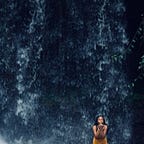#TembeaKenya
……And no I don’t mean insects or viruses.
In the last couple of weeks, I watched the sunrise in Makueni County and ended the week watching the sunset in Nyandarua County. I transversed five counties in Kenya in less than three days. Three of these counties were a cost-free trip better known as a work trip and for two other counties, it was a self-treat which cost Ksh.2,000, thanks to Lets Drift.
Makueni County, it was a cloudy morning and the sunrise was covered up, I captured it in the car when it was less cloudy ( I did not like the image, so I will not upload it).
Taita -Taveta County
Igho Ja Wesu ( translates to the stone/Rock of Wesu) in Taita—Taveta County, kind of reminds me of pride rock which is coincidently inspired by the many places in Kenya. This is also one of my best friend's hometown, their home is under the Igho Ja Wesu. According to her dad,
“It is believed that the Igho Ja Wesu was the rock of death, community members who went against the social norms of the village were thrown off it by their close relatives usually their uncles after a verdict was given by the elders’ court”
I also got to visit the gemstone centre in Voi, where I learned just how valuable gemstones are and how they are cut. The centre will be able to bridge the gap between artisanal small-scale miners (ASMs) and traders without the ASMs getting swindled which is very common at the moment.
Nyandarua County
Sasumua dam, in Njabini Nyandarua county, provides 11 % of water to Nairobi. Water from the Aberdares drains into this dam. The dam was constructed on the Sasumua River in the 1950s. There are a couple of things that I learned you cannot do on this dam:
- No swimming — Contaminates the dam, if found by local authorities you will be jailed.
- No boat riding — Contaminates the dam, if found by local authorities you will be jailed.
- No Fishing — I was informed the dam does not have any fish however it has crayfish, which the locals in Njabini fish. They set up nets inside the dam that collect the Crayfish. Our Guide Maish showed us how it is eaten; they cut off the tail from the creature, which is what will be eaten. The head is put back in the water and it will eventually grow back its tail, talk about sustainable fishing. Some brave drifters indulged in this cuisine ( raw).
- More facts on dams.
I was also taught the technique of making a rock bounce water. The secret is in finding a flat rock and voila!
We hiked around the dam ( less than 10 km) and came across a mini waterfall. Around it was a flock of sheep and a herd of cattle. It is said that when you find a flock of sheep, you will not find any wild animals, this is because sheep are said to be very helpless and clueless and therefore have to graze in safe fields. Another theory my genius friend Andrew came up with is that black sheep could be called so, because unlike the white sheep that always have to travel in a flock the black one is always on its own and can navigate grazing fields on its own. Not sure how true this is, feel free to do a dissertation on it if there is none.
Here’s to more adventures.
